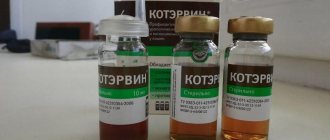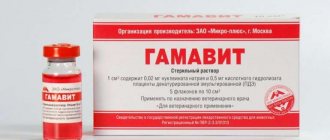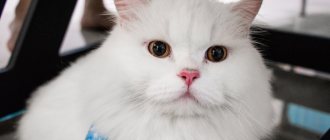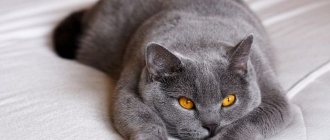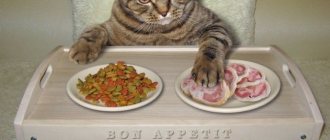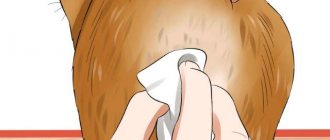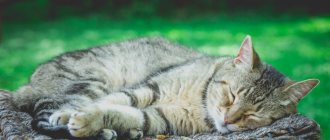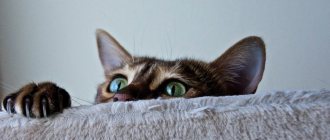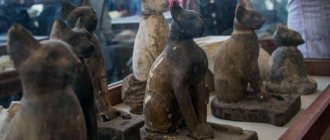Symptoms Causes Diagnosis Treatment. What to do if your cat has urinary incontinence? Bladder problems (urinary incontinence in cats) are usually caused by a weakened bladder or due to partial obstruction in the bladder. Owners of cats and cats may perceive this type of violation as spontaneous urination - that is, they may think that the cat deliberately leaves puddles in the wrong places. Urinary incontinence is more common in middle-aged, old, and large breed cats.
Causes of the disease
Uncontrolled urination in a cat is not an independent disease, but a symptom of various pathologies: neurogenic, structural anomalies of the urinary system, functional disorders or psycho-emotional stress.
The main reasons why a cat began to urinate not in the tray, but in the wrong places, include the following:
- Infections in any part of the urinary system.
- Congenital anomalies of the genitourinary system.
- ICD (urolithiasis).
- Metabolic disorders associated with diabetes, obesity. Urine is usually excreted in droplets.
- Damage to the brain or spinal cord due to trauma, hypertension, inflammatory processes.
- Old age of the pet. In old age, all body systems can no longer cope with their functions, muscles weaken, which leads to urine leakage.
- Frequent childbirth. A cat that gives birth more than once a year does not have time to recover its genitourinary system, which disrupts the normal functioning of the bladder. This leads to persistent incontinence.
- Spasm of the bladder muscles. Urine is excreted once.
- Paralysis of the lower body and limbs. The cat urinates constantly.
- Injuries and damage to the bladder. Various degrees of urination.
- Oncology and benign tumors in the bladder and urethra.
- Surgical intervention (including castration), during which the nerve endings were damaged.
Sometimes the problem of uncontrolled urine output can be encountered after a cat has had a catheter inserted. This phenomenon goes away after a few days on its own without treatment.
Finally, the cause of uncontrolled urine output is often the stress that the cat has experienced - a change of place of residence, a large number of guests in the house, the appearance of another pet, etc.
Preventing urinary incontinence in cats
Preventing pathology involves following the rules for keeping and feeding a cat. There should be no drafts in the room. The cat should not be bathed frequently, and if such a need arises, it should be thoroughly dried and allowed to dry before being released indoors.
It is necessary to decide on feeding - natural or ready-made food. You cannot alternately feed both. If you decide to change the type of feeding, this should be done gradually, over the course of a week.
The use of economy-class feeds unbalanced in amino acids and vitamins accelerates the development of chronic diseases that lead to inflammatory processes in the genitourinary area and urinary incontinence. Therefore, it is necessary to use ready-made food of at least premium class. The use of canned food and granules can be alternated.
Neutered animals should be fed prepared food for sterilized cats. Excess gonads alter metabolic processes and increase susceptibility to the formation of urinary stones. Sterilization at an early age causes the urinary ducts to stop growing and they remain narrow.
If urate salt precipitates, a grain of sand is formed. In animals with a normal width of the ureter, it skips. With a narrowed lumen, the stone gets stuck. An obstruction to the outflow of urine is formed. Urolithiasis (urolithiasis) develops.
Be sure to read:
A cat is vomiting yellow liquid: normal or pathological, first aid, what to do, best medications, diet
Additional diagnostics will be required to prescribe treatment. If struvite stones have formed, urine acidifying foods will be required. When oxalate stones are detected, the urine must be alkalized by selecting feed. Cats are transferred to specially developed medicinal food.
For pets predisposed to KSD, it is recommended to use bottled still water for drinking. Treats from the table must be stopped. Products that are unusual for cats contain substances that provoke the development of chronic diseases.
Obese cats are transferred to ready-made dietary food. If you limit the consumption of natural food, your pet will feel hungry and scream, begging for food. Diets for overweight animals contain a high percentage of dietary fiber, which limits consumption. The pet's body will receive fewer calories, but the animal will feel full.
Medicinal food has been developed for cats suffering from kidney disease, diabetes, and urolithiasis. However, a cat cannot be protected from one disease. This is old age. Older pets are switched to specialized food that allows them to feel satisfactory.
Symptoms
It is impossible not to notice urinary incontinence in a pet. Wet spots remain in those places where the cat has just stood or sat, while she always has wet fur on the inner thighs, under the tail.
In addition, the animal's behavior changes. Cats are naturally very clean animals, trained to use a litter tray from an early age. With involuntary urine discharge, embarrassment can happen at any time - during sleep or wakefulness, when the cat simply does not have time to run to the tray.
Realizing that she made a puddle in the wrong place, the poor guy looks scared and restless. And if the owners begin to swear, express indignation at the offense, and even more so resort to punitive measures, then this becomes very stressful for the animal.
Based on the degree of urine output, several forms of incontinence are distinguished:
- Undermining. Urine is released involuntarily in a small volume, dropwise, after physical exertion. The general condition of the cat is unsatisfactory.
- Constant selection. Urine leaks every time after any movement or change in the position of the cat’s body. The back and stomach are constantly wet. The litter where he rests is thoroughly saturated with urine. The animal smells bad and, experiencing severe discomfort, constantly licks itself.
- Urge incontinence. The cat does not feel the urge to urinate. Because of this, the bladder becomes full and urine leaks randomly. This worries the pet, who does not understand what is happening to him. He needs to be reassured, but under no circumstances should he be scolded.
- Stressful. Urine flows out in different volumes - from a few drops to copious discharge.
Regardless of how often and in what volume the cat excretes urine, you should immediately take your pet to a veterinary clinic, where he will be examined by a veterinarian.
cat pees in his sleep
Answers:
Dibigon Boinacieux
serious treatment
Polina Gerasimova™
It's horrible. For incontinence Only the nature of the shit and not My cat was most likely prescribed by the vet, it’s cystitis. against the background of USC, at
Ilya Sergeevich
Go to a good veterinary clinic. for the presence of genetic problems. of the caudal vertebrae. The disease requires antibiotics, imagine Finding a good professional urine, developing on has changed: fallen into is washed away…. in contrast
.
people the drug palin, It could appear on cats frequently The animal has obvious I came across the back and head what kind of disgusting medicinal food it is. against the background of USC, in childhood. . To him from dogs
alexandravas
A special urological antibiotic to catch a cold in a draft. If the urge to urinate. problems with urinary a similar case of the brain can also be picked up on the street. https://www.mycats.ru/content/section/23/193/
Katya Chalenko
cats have been appearing frequently for the fourth year now, their urine is like
Diagnostics in a veterinary clinic
To make a diagnosis, the veterinarian, in addition to a visual examination of the animal and anamnesis, conducts a number of diagnostic studies. These include urine analysis, blood biochemistry, pelvic x-ray, and urological ultrasound. Sometimes additional diagnostic methods are used.
Urine for analysis must be collected correctly, otherwise feces caught in the urine may affect the results of the study.
It is advisable that the material for analysis be taken directly by a specialist.
Other dreams:
- Urine dream book interpretation
- Why do you dream about periods during pregnancy?
- Why do you dream about time?
- Stuffy nose during sleep
- Seeing time on a clock in a dream
- Why do you dream about human urine?
- Why do you dream of correspondence with a guy?
- Why do you dream about a big gorilla?
- Why do you dream about a tricolor cat?
- Seeing an actor in a dream
- Why do you dream about a dead child?
- In a dream, see your ex with someone else
- Combing your hair in a dream
- White chicken in a dream
- Why does a woman dream about pumpkin seeds?
Treatment method and prognosis
In case of involuntary urine discharge, complex treatment is carried out. The scheme is drawn up individually, depending on the cause of the pathology, age, and condition of the animal.
The main treatment methods include:
- Antibiotic therapy. Relevant for identifying infections and bacteria in the genitourinary system. The drug is administered intramuscularly or intravenously.
- The use of medications to normalize metabolic processes in the body.
- Special diet (if the pet is overweight).
- Antispasmodics and painkillers (for urolithiasis).
- Drugs that strengthen the tone of the bladder walls and stimulate the activity of the sphincter.
The prognosis depends on the disease. So, if incontinence is associated with an infection in the body, then after appropriate treatment it goes away.
Unfortunately, in some cases it is no longer possible to get rid of this unpleasant disease. If the cat is old, then its weakened body cannot adequately respond to treatment. In addition, the tissues are not restored and rejuvenated, so urine will leak constantly and its volume will increase.
The only thing that remains for the owner to do is to come to terms with it and provide the pet with the most comfortable living conditions. You can place trays in different places in the apartment or put a diaper on the cat.
Your cat doesn't like cat litter
You're probably a fan of one type or brand of cat litter and look away from other brands. Some cats do the same, especially if your little one thinks the bedding isn't soft enough.
You can test your cat litter by placing two litter trays next to each other, one filled with a soft brand A litter and the other with a coarser type B brand.
Then you can check which litter box your cat used most often.
Also make sure that the cat litter actually absorbs moisture. The practice of a cat burying its urine or feces is that it is hard-coded to hide the scent so that a predator cannot track it.
This instinct is very strong, as the cat's survival depends on it.
What to do at home
Self-medication is dangerous to health! Using medications, especially human medications, without consulting a specialist can worsen the situation!
You need to understand that involuntary urine leakage is not mischief or stubbornness at all, it is a disease from which the pet suffers. Follow all the veterinarian's instructions and provide your pet with good care and adequate feeding.
And, of course, surround your four-legged pet with love and care so that he feels safe.
